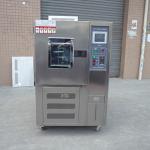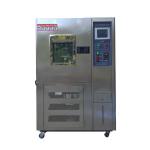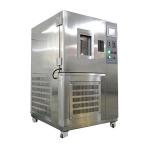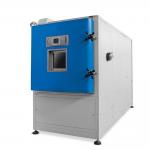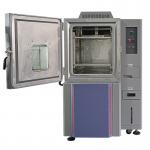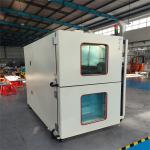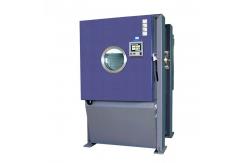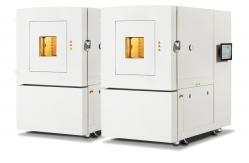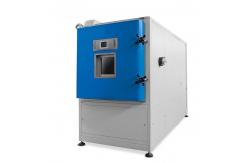In the highly demanding and technologically advanced field of
aerospace, the need for accurate and comprehensive testing of
components, systems, and materials is non-negotiable. The
customized Aerospace/Altitude/Space Simulation Combined Temperature
Altitude Humidity Chamber stands as a pinnacle of engineering
excellence, designed to replicate the extreme and diverse
environmental conditions that aerospace assets encounter throughout
their lifecycle. This state-of-the-art chamber is specifically engineered to serve
the aerospace industry, including manufacturers of aircraft,
spacecraft, satellites, and associated components. Its primary
purpose is to conduct highly precise simulations of temperature,
altitude, and humidity conditions that mimic the harsh realities of
flight, from ground-level operations to the vacuum and extreme
temperatures of outer space. By subjecting aerospace equipment to
these meticulously controlled environments, engineers and
researchers can evaluate performance, durability, and reliability,
thereby ensuring the safety and success of aerospace missions. - Robust and High-Pressure Chamber Structure
- The chamber is constructed with a heavy-duty, aerospace-grade steel
frame that provides unparalleled rigidity and strength. The frame
is meticulously welded and treated to withstand the immense
pressure differentials and mechanical stresses associated with
altitude and space simulations. The chamber walls are made of
specialized composite materials and advanced insulation, which
minimize heat transfer and maintain precise temperature and
humidity levels. The insulation is engineered to endure the rigors
of extreme cold and rapid temperature changes, while also
preventing any external factors from compromising the internal test
environment. The chamber is equipped with a hermetic door seal and
multiple pressure relief valves, ensuring a leak-free enclosure and
safe operation under varying pressure conditions.
- Precision Temperature, Altitude, and Humidity Control System
- The integrated control system is a marvel of technological
sophistication. It can accurately replicate a wide range of
temperatures, from -100°C in the frigid depths of space to +200°C
in the heat of re-entry or engine operation. The altitude
simulation capabilities extend from sea level to the vacuum of
space, with the ability to precisely control pressure levels as low
as 10^-6 torr. The humidity control range spans from near-zero
dryness to saturated conditions, with an accuracy of ±2% RH. The
system employs advanced refrigeration units, heating elements,
vacuum pumps, and humidifiers/dehumidifiers, all coordinated by a
sophisticated computerized control algorithm. Temperature,
pressure, and humidity sensors are strategically placed throughout
the chamber to provide real-time feedback, enabling the control
system to make instantaneous and highly accurate adjustments.
- Vacuum and Space Simulation Capabilities
- The chamber is equipped with a high-performance vacuum system that
can create a near-space vacuum environment. It can evacuate the
chamber to extremely low pressures, simulating the conditions of
outer space. This allows for the testing of components and systems
in a microgravity and vacuum environment, evaluating their behavior
in the absence of atmospheric pressure and the presence of cosmic
radiation. The chamber also features radiation simulation
capabilities, using specialized light sources and shielding
materials to replicate the effects of solar and cosmic radiation on
aerospace materials and electronics.
- Advanced Data Acquisition and Monitoring System
- A comprehensive data acquisition and monitoring system is an
integral part of the chamber. It records and analyzes a vast array
of parameters, including temperature profiles, pressure changes,
humidity levels, and the performance of the test samples. The
system can monitor electrical signals, mechanical vibrations, and
other critical indicators of component health. The data is
continuously logged and can be visualized in real-time on a
user-friendly interface. Additionally, the system has the ability
to generate detailed test reports, complete with graphs, charts,
and statistical analysis, providing engineers with a wealth of
information for performance evaluation and design optimization.
- Customizable Test Fixturing and Sample Handling
- The chamber is designed with flexibility in mind, allowing for the
accommodation of a wide variety of aerospace components and
systems. It features customizable test fixturing and sample
handling mechanisms that can be adjusted to fit the specific
geometry and requirements of the test samples. Whether it's a small
electronic circuit board, a large rocket engine component, or a
complete satellite subsystem, the chamber can be configured to
ensure proper positioning, connection, and exposure to the
simulated environment. The interior surfaces are made of
non-reactive and non-outgassing materials to prevent any
contamination or interference with the test samples.
- Enhanced Safety and Emergency Systems
- Safety is of utmost importance in aerospace testing. The chamber is
equipped with a comprehensive suite of safety features, including
emergency stop buttons located both inside and outside the chamber
for immediate shutdown in case of any anomalies. It has
overpressure protection systems, fire suppression systems, and leak
detection sensors for refrigerants and other gases. The chamber is
also designed to handle potential failures of the vacuum system or
other critical components in a safe and controlled manner, with
backup power supplies and redundant safety circuits to ensure the
integrity of the testing process and the protection of personnel
and equipment.
- Temperature Range and Rate of Change
- The chamber can maintain a temperature range from -100°C to +200°C.
The rate of temperature change can be adjusted up to 30°C per
minute, allowing for rapid transitions between extreme cold and hot
conditions. This is crucial for simulating the temperature
differentials that occur during spaceflight, such as the rapid
heating during re-entry or the extreme cold of deep space. For
example, a spacecraft's heat shield must be able to withstand the
intense heat of re-entry, and this chamber can accurately replicate
those conditions to test its performance.
- Altitude Simulation Range and Pressure Accuracy
- The altitude simulation range extends from sea level (101.3 kPa) to
the vacuum of space (as low as 10^-6 torr). The pressure control
accuracy is within ±0.1% of the set value. This precise altitude
and pressure control is essential for testing the performance of
aerospace components, such as aircraft engines, which experience
significant pressure changes during flight. It also allows for the
evaluation of the effects of low pressure on materials,
electronics, and mechanical systems, such as the potential for
outgassing or the degradation of seals and lubricants.
- Humidity Cycling Range and Rate
- The humidity can be cycled from near-zero to saturated conditions,
with a rate of change of up to 10% RH per minute. In aerospace
applications, humidity can have a significant impact on the
performance and reliability of components. For instance, high
humidity can cause corrosion of metal parts or affect the
performance of electronic circuits. The chamber's humidity control
capabilities enable the testing of components under different
moisture levels, simulating the diverse environments that aerospace
assets may encounter, from humid tropical regions to the extremely
dry conditions of space.
- Testing Volume and Payload Capacity
- The chamber offers a customizable testing volume, with options
ranging from 1 m³ to 20 m³. The payload capacity can be adjusted
according to the size and weight of the test samples, with a
maximum capacity of up to 5000 kg. This flexibility allows for the
testing of a wide range of aerospace products, from small avionics
components to large structural assemblies
|
